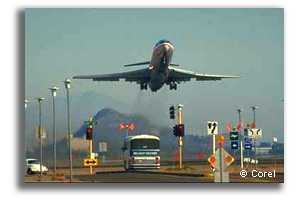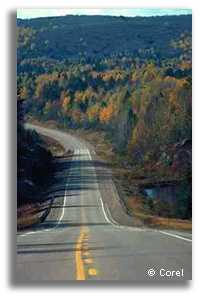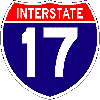Click
Here to return to the previous page
Paul Sparks
- Online English Lesson Plans, Lesson Material and Ideas for "Culture of
English Speaking Countries Lessons" for Xiangtan Normal University...
WESTERN CULTURE AND SOCIETY: THE UNITED STATES OF
AMERICA (USA) -
American Transport
AMERICAN TRANSPORT: Air Travel is the
most practical and common method of covering the large distances
between areas in the USA. It is the fastest, the most convenient and
frequently the most economical means of transportation.
 Trains
are not as popular in the USA as they are in many other countries.
They are an acceptable choice only for short or medium distance travel
in certain areas. In many major cities, commuter trains provide good
passenger service from suburban communities to the downtown
metropolitan centers. In many parts of the US, train service may be
infrequent or even non-existent. Trains
are not as popular in the USA as they are in many other countries.
They are an acceptable choice only for short or medium distance travel
in certain areas. In many major cities, commuter trains provide good
passenger service from suburban communities to the downtown
metropolitan centers. In many parts of the US, train service may be
infrequent or even non-existent.
Busses are an
economical option. Bus transportation is a great option for urban or
suburban transit, but bus service can be very limited in rural areas.
The Greyhound Bus line offers inter-city and transcontinental bus
service. It can be an inexpensive alternative to other forms of travel
if you are willing to put up with the discomfort of long rides with
minimum comforts.
Cars are almost a
necessity. In many parts of the USA where public transportation is
inadequate or non-existent, a car is a practical necessity. In most
large cities, the major shopping centers and sports or entertainment
facilities are usually located in the suburban communities far from
the metropolitan center. Without a vehicle, sightseeing, shopping and
touring can be very inconvenient.

Hitchhiking is not
permitted in most states. Hitchhiking is illegal in many states. You
may occasionally see a person trying to "hitch a ride" along
an interstate or at the entry to a toll road, but they are often
risking a fine if apprehended by a police patrol.
Bicycles are a
good way to see the USA. But bicycles are not as common in the US as
they are in many other countries, so car and truck drivers are not as
accustomed to bicyclist on the roads. Bicycles are banned from the
freeways and interstate highways, but are permitted on all other
roads. Many cities and towns have off-road bicycle paths and trails.
Car rental prices
are very competitive in most states and no single agency has the best
prices every time. Prices change frequently and every agency offers
many special promotions and competitive priced deals. If you spend
some time shopping for the best price, you can often save money. Here
are some tips on how to find the best prices and how to save money.
Each of the 50
states has its own set of traffic laws and regulations. Fortunately,
most of the laws are the same, but some states have slightly different
rules.
The speed limit in
most states is now 65 miles per hour (about 110 km/hr) except where
signs indicate slower speeds. Many drivers travel about 5 mph above
the legal limit and the police do not seem to mind. Speed limits are
strictly enforced by radar in many states (especially the eastern
highly populated areas). In the western states, enforcement can be
much more lax and motorists frequently travel at 85 mph or more.
Speeding in any road construction area is strictly enforced with very
heavy penalties in most states.
 The
minimum age for driving is 16 in most states but some states will not
allow unrestricted driving until 18. Some car rental agencies refuse
to rent a car to any person under 25 years of age. Some rental
agencies in the US will not rent to drivers over 71 years of age. Nearly
all states have laws requiring the driver and front passengers to wear
seat belts. Many states require children to wear seat belts even in
the back seats. Nearly every state requires special child restraint
seats for all young children. Most states require motorcyclists to
wear helmets. The
minimum age for driving is 16 in most states but some states will not
allow unrestricted driving until 18. Some car rental agencies refuse
to rent a car to any person under 25 years of age. Some rental
agencies in the US will not rent to drivers over 71 years of age. Nearly
all states have laws requiring the driver and front passengers to wear
seat belts. Many states require children to wear seat belts even in
the back seats. Nearly every state requires special child restraint
seats for all young children. Most states require motorcyclists to
wear helmets.
 The
speed limit in front of every school is 15 mph when the warning lights
are flashing. You are required to stop in both directions for any
school bus with flashing lights. These rules are strictly enforced in
every state and have severe penalties for disobedience. Drinking
alcohol and driving is also forbidden and strictly enforced in all
states. The
speed limit in front of every school is 15 mph when the warning lights
are flashing. You are required to stop in both directions for any
school bus with flashing lights. These rules are strictly enforced in
every state and have severe penalties for disobedience. Drinking
alcohol and driving is also forbidden and strictly enforced in all
states.
The American
Automobile Association (AAA), commonly called the "triple
A", provides some wonderful services to drivers. They have
offices in every city and most of the larger towns in the US. If you
are a member of a national motor club in your home country, you can
receive many of their benefits free of charge by simply showing your
membership card. The AAA provides free maps and tourist guides for any
city or state in the US.
The US highway
system - The USA has an extensive system of interstate highways and
state maintained roads. Some of the major highways are toll roads
often called turnpikes, but most are free. All major interstate
highways running north to south have odd numbers and are ordered from
I-5 on the Pacific coast to I-95 along the Atlantic coast. All
interstates running east to west are evenly numbered beginning with
I-8 and I-10 near the Mexican border to I-94 near Canada.
|